I recently watched an amazing documentary about how Adam Ondra clawed his way up literally the world’s toughest climb.
After FOUR YEARS of preparation he finally pulled off the hardest, most technical climbing challenge ever mastered, on September 3rd, 2017.
There are a lot of lessons in this documentary for BJJ athletes! In fact it’ll help you with ANY seemingly impossible athletic challenge…
Adam Ondra Climbing Silence, The Video
There are whole bunch of ways to waste time on the internet. But here’s a video that’s most definitely NOT a waste of time.
If you do any kind of sport, if you push yourself in any way, if you have even one audacious and slightly scary goal, then this mini-documentary following Adam Ondra as he prepares to slither his way up the most difficult climb in the world is really inspiring.
I’ll discuss some very concrete lessons for non-climbers below, but first, here’s the video:
Why Is This Climb is So Difficult
Silence is an insane rock-climbing route. It’s about 45 meters (or 150 feet) along the underside of a giant cave roof in Norway.
In climbing there are rankings of difficulty. A climb ranked as a class 1 is basically a rocky uphill hike, and a class 5 is considered technical climbing. If you fall on a 5 you could severely hurt or kill yourself, which is why you see all those ropes, carabiners and harnesses.
But class 5 is itself divided into further subclasses, the most difficult being 5.15d. The climbing rating system doesn’t go any higher than this.
As of February 2019, nobody else other than Adam had ever climbed a 5.15d. He’s the only one.
The whole climb is brutal. The first 20 meters of it would be impossible for everyone except a master climber, and serve to exhaust you.
But then you hit the hardest parts: 3 crux moves.
The craziest part is so difficult that the only way to get up the rock is to turn upside down and climb a section feet-first. Here’s what it looks like:
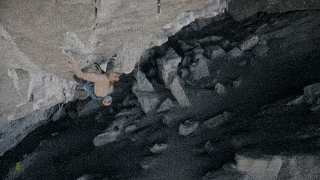
OK, I think you get the picture. Insanely difficult climb that only one person in the world has ever done.
Now how did he do it?
Extensive Background in the Sport
Adam started climbing at age 6 with his parents. He started winning youth climbing competitions when he was 14. And he was 24 when he ascended the hardest climb in the world.
So that’s 18 years in climbing gyms, in competitions, on easy routes and on hard routes. That’s 18 years of making mistakes, correcting them, moving on, and experiencing minor and major victories at a very high level of climbing.
This collective experience forms a foundation of knowledge and conditioning that all his other achievements are built on.
Whether it’s climbing, jiu-jitsu, the Tour de France or strongman competitition, first you have to put in the time to build yourself one hell of a base.
Specificity of Training
Once you have the base of experience in the generalities of a sport it’s time to occasionally start training specifically for certain projects.
Let’s look at this in BJJ terms…
If a jiu-jitsu athlete wants to win a medal in the black belt division at the world championships he first has to put in years and years on the mat. He has to learn techniques and strategies from every position and make them totally instinctive.
Then he has to get a LOT of tournament experience to bring his nerves under control, learn the nuances of the rules, and figure out how to deal with different types of opponents.
Only then is he ready to undergo a very specific training, preparation and peaking cycle that maybe gives him a shot at the world title.
As a world class climber Adam Ondra started out with a hell of a base. He was already off the charts with technical skill, endurance, mental tenacity and grip strength.
However Adam still had to change his training to prepare himself for Silence.
He really was willing to do whatever was required to reach his big, hairy, audacious goal.
It took 4 years of training, planning and travelling from the Czech Republic to Norway to spend time in the actual cave.
He fell off the route hundreds of times.
He conditioned his calves so he could put his foot on a hold and jam his knee against a rock to hang upside down because it was the only way to rest his hands in the climb!
He built a simulation of the hardest parts of the climb in his own gym.
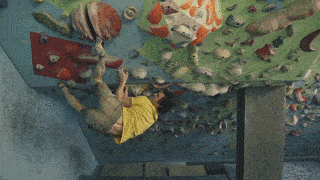
Then he built a SECOND climbing wall in a barn in Norway, close to the cave. This was so he could warm up properly before tackling the cave itself.
It doesn’t get more specific than that.
Grip Training
Earlier I mentioned grip strength. All elite climbers have amazing grip strength but Adam takes it to another level.
He’s spent thousands of hours strengthening his fingers on hangboards and campus boards.
When I see the little nubbins of rock he’s gripping in some of his other climbs I think, “Good lord, if this kid ever started jiu-jitsu his spider guard would be from another planet!”
Certainly grip strength is important in grappling. If you lose a grip you might not finish a submission or lose a match.
It’s even more important in climbing. After all, if your grip fails on a cliff then you might get injured or die.
The 3 basic categories of grip strength are the crush grip, pinch grip, and support grip. In climbing it gets even more specific than that… If a route is hard enough then the difference between success and failure might literally come down to the strength of the 3rd finger on your left hand.
But the climb in Norway has a lot of large, sloping holds instead of the smaller holds more common on climbing walls. So he started only using the larger holds in his training to more closely simulate the cave climb
The specificity of training required that he take his already strong grip and work it in the exact specific position required.
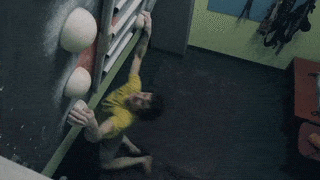
Visualisation and Muscle Memory Rehearsal
One of the most interesting parts of the documentary video was at the 9 minute mark. Here they covered when Adam got sick, couldn’t train hard, but needed to keep improving.
Instead of beating himself up on the climb he and his physiotherapist, Klaus Isele worked through the different moves in a two person dance to maintain his muscle memory and neurological patterns of the climb.
This way when hard training resumed again the critical moves were still all fresh in his mind. It’s really quite an amazing example of the power of physical and mental rehearsal.
You’ve heard of shadowboxing, right?
Well, this was shadowclimbing…
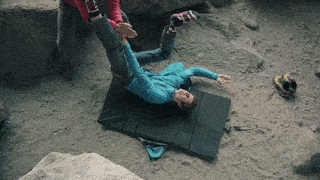
Many top fighters spend significant amounts of time each day thinking about, mentally rehearsing, and visualising their moves. They watch videos of their opponents to become familiar with their movement patterns. They shadowbox specific counters over and over.
This ongoing mental rehearsal is a common denominator for all top performers.
Specificity of Training in BJJ and MMA
To succeed in BJJ you need to have a wide base of experience and general fitness.
But to really sharpen the blade you may need to do some training that mimics the moves you most rely on.
Guys do thousands of reps of their favorite techniques. That’s specificity.
Or they may apply specificity to their conditioning too…
For example, pullups are a really important exercise for grappling, but a spider guard specialist may need to do some pullups hanging onto the sleeves or lapels of a gi. A wrestler may need to do bodylock pullups. And so on…
My friend, BJJ world champion Bernardo Faria trained movements with his trainer that mimicked his guard passes and guard sweeps exactly…
MMA fighters often bring in specific sparring partners to mimic their opponents. They’ll seek out southpaws if their next opponent fights right side forward. High level wrestlers if their opponent is good at takedowns. BJJ black belts if their opponent is good at submissions.
The craziest example I can think of comes from the 5′ 9″ Japanese fighter Ikuhisa Minowa when he was getting ready to fight 7′ 2″ fighter The ‘Giant’ Silva in Pride. Minowa was at such a height disadvantage that he sometimes had a training partner sit on another man’s shoulders and chase him with two kendo swords just to simulate the unearthly reach of his opponent.
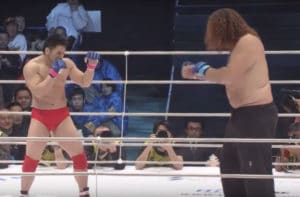
(Sadly I only ever met and trained with Minowa once, and that was in 2003 before this crazy fight, so I never had the opportunity to ask him if this three man training really helped in the fight. But he did end up winning the match, so maybe it’s not as crazy as it seems.)
All of these examples point to concept becoming more specific in your training as you approach a difficult challenge, and you’d be a fool to ignore it.
Doing Whatever It Takes
Ultimately any difficult goal is going to take a TON of work.
And you can’t get extraordinary results from ordinary training methods.
Attempting something that is nearly impossible is going to take everything you’ve got.
So when it comes to this ultra-elite level of perfomance – climbing an impossible 5.15d route, winning the world championships, doing an ultramarathon – then extreme measures come with the territory.
This single-minded focus and continuously trying to figure out how to do things better is a necessity to push yourself to highest level.
I’ll leave you with a one of my favorite quotes…
Hope you found this useful, or at least interesting!
Stephan
The post What Grapplers Can Learn From The Best Rock Climber in the World. appeared first on Grapplearts.
